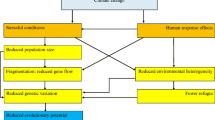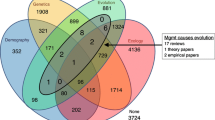Abstract
Conservation biology needs to be concerned not just with exogenous threats to populations, but also with the changing nature of populations themselves. In a previous review paper, we highlighted evolution in contemporary time (years to decades) as a largely overlooked aspect of population responses to environmental perturbations. We argued that these responses might affect the fate of natural, managed and exotic populations. In the present review, we discuss issues that may limit the integration of contemporary evolution into conservation biology—with the intent that recognition of these limitations may foster research, discussion and resolution. In particular, we consider (1) alternative perceptions of “evolutionary” and “ecological” time, (2) the role of contemporary evolution as an ecological process, (3) fitness as a bridge between evolution and conservation, and (4) challenges faced by conservation strategies based on gene flow estimation or manipulation. We close by highlighting some situations in which current conservation approaches and contemporary evolution may require reconciliation.

Similar content being viewed by others
References
Alleaume-Benharira M, Pen IR, Ronce O (2006) Geographical patterns of adaptation within a species’ range: interactions between drift and gene flow. J Evol Biol 145:203–215
Amos W, Balmford A (2001) When does conservation genetics matter? Heredity 87:257–265
Ariew A, Lewontin RC (2004) The confusions of fitness. Br J Philos Sci 55:347–363
Ashley MV, Willson MF, Pergams ORW, O’Dowd DJ, Gende SM, Brown JS (2003) Evolutionarily enlightened management. Biol Conserv 111:115–123
Avise JC, Hamrick JL (1996) Conservation genetics: case histories from nature. Chapman & Hall, New York
Bailey JK, Wooley SC, Kindroth RL, Whitham TG (2006) Importance of species interactions to community heritability: a genetic basis to trophic-level interactions. Ecol Lett 9:78–85
Bone E, Farres A (2001) Trends and rates of microevolution in plants. Genetica 112–113:165–182
Boulding EG, Hay T (2001) Genetic and demographic parameters determining population persistence after a discrete change in the environment. Heredity 86:313–324
Bridle JR, Vines TH (2007) Limits to evolution at range margins: when and why does adaptation fail. Trends Ecol Evol 22:140–147
Burt A (1995) The evolution of fitness. Evolution 49:1–8
Carroll SP, Klassen STP, Dingle H (1998) Rapidly evolving adaptations to host ecology and nutrition in the soapberry bug. Evol Ecol 12:955–968
Caughley G (1994) Directions in conservation biology. J Anim Ecol 63:215–244
Collyer ML, Novak JM, Stockwell CA (2005) Morphological divergence of native and recently established populations of White Sands pupfish (Cyprinodon tularosa). Copeia 2005(1):1–11
Cowles HC (1899) The ecological relations of the vegetation on the sand dunes of Lake Michigan. Bot Gaz 27:95–117 see also 167–202, 281–308, 361–391
Darwin C (1859) On the origin of species by means of natural selection, or the preservation of favoured races in the struggle for life. John Murray, London
Ebert D, Haag C, Kirkpatrick M, Riek M, Hottinger JW, Pajunen VI (2002) A selective advantage to immigrant genes in a Daphnia metapopulation. Science 295:485–488
Ferriere R, Diekmann U, Couvet D (2004) Evolutionary conservation biology. Cambridge University Press, Cambridge
Fisher RA (1930) The Genetical theory of natural selection. Clarendon Press, Oxford
Frankham R (2005) Genetics and extinction. Biol Conserv 126:161–140
Fussman GF, Loreau M, Abrams PA (2007) Eco-evolutionary dynamics of communities and ecosystems. Funct Ecol (in press)
Garant D, Kruuk LEB, Wilkin TA, McCleery RH, Sheldon BC (2005) Evolution driven by differential dispersal within a wild bird population. Nature 433:60–65
Garant D, Forde SE, Hendry AP (2007) The multifarous effects of dispersal and gene flow on contemporary adaptation. Funct Ecol (in press)
Garcia-Ramos G, Kirkpatrick M (1997) Genetic models of adaptation and gene flow in peripheral populations. Evolution 51:21–28
Gilligan DM, Frankham R (2003) Dynamics of genetic adaptation to captivity. Conserv Genet 4:189–197
Gilpin ME, Soulé ME (1986) Minimal viable populations: processes of species extinction. In: Soule ME (ed) Conservation biology: the science of scarcity and diversity. Sinauer, Sunderland, pp 19–34
Gingerich PD (1983) Rates of evolution—effects of time and temporal scaling. Science 222:159–161
Gomulkiewicz R, Holt RD (1995) When does evolution by natural selection prevent extinction? Evolution 49:201–207
Gomulkiewicz R, Holt RD, Barfield M (1999) The effects of density dependence and immigration on local adaptation and niche evolution in a black-hole sink environment. Theor Popul Biol 55:283–296
Grant PR, Grant BR (1995) Predicting microevolutionary responses to directional selection on heritable variation. Evolution 49:241–251
Hairston NG Jr, Ellner SP, Geber MA, Yoshida T, Fox JA (2005) Rapid evolution and the convergence of ecological and evolutionary time. Ecol Lett 8:1114–1127
Hanski I, Saccheri I (2006) Molecular-level variation affects population growth in a butterfly metapopulation. PLoS Biol 4(5):e129
Heath DD, Heath JW, Bryden CA, Johnson RM, Fox CW (2003) Rapid evolution of egg size in captive salmon. Science 299:1738–1740
Hedrick PW (1995) Gene flow and genetic restoration: the Florida panther as a case study. Conserv Biol 9:996–1007
Hedrick PW, Kalinowski ST (2000) Inbreeding depression in conservation biology. Ann Rev Ecol System 31:139–162
Hedrick PW, Lacy RC, Allendorf FW, Soulé ME (1996) Directions in conservation biology: comments on Caughley. Conserv Biol 10:1312–1320
Hendry AP, Kinnison MT (1999) The pace of modern life: measuring rates of contemporary microevolution. Evolution 53:1637–1653
Hendry AP, Wenburg JK, Bentzen P, Volk EC, Quinn TP (2000) Rapid evolution of reproductive isolation in the wild: evidence from introduced salmon. Science 290:516–518
Hendry AP, Day T, Taylor EB (2001) Population mixing and the adaptive divergence of quantitative traits in discrete populations: a theoretical framework for empirical tests. Evolution 55:459–466
Hendry AP, Farrugia T, Kinnison MT (2007) Human influences on rates of phenotypic change in wild animal populations. Mol Ecol doi:10.1111/j.1365-294X.2007.03428.x
Hogg JT, Forbes SH, Steele BM, Luikart G (2006) Genetic rescue of an insular population of large mammals. Proc R Soc Lond B Biol Sci 273:1491–1499
Holt RD, Gomulkiewicz R (1997) How does immigration influence local adaptation? A reexamination of a familiar paradigm. Am Nat 149:563–572
Holt RD, Gomulkiewicz R, Barfield M (2003) The phenomenology of niche evolution via quantitative traits in a ‘black-hole’ sink. Proc R Soc Lond B Biol Sci 270:215–224
Johnson MTJ, Agrawal AA (2003) The ecological play of predator–prey dynamics in an evolutionary theater. Trends Ecol Evol 18:549–551
Kinnison MT, Hendry AP (2001) The pace of modern life II: from rates of contemporary microevolution to pattern and process. Genetica 112–113:145–164
Kinnison MT, Hairston NG Jr (2007) Eco-evolutionary conservation biology: contemporary evolution and the dynamics of persistence. Funct Ecol 21:444–454
Kinnison MT, Unwin MJ, Quinn TP (2007) Eco-evolutionary versus habitat contributions to invasion in salmon: experimental evaluation in the wild. Mol Ecol (in press)
Lambrinos JG (2004) How interactions between ecology and evolution influence contemporary invasion dynamics. Ecology 85:2061–2070
Lande R (1988) Genetics and demography in biological conservation. Science 241:1455–1460
Law W, Salick J (2005) Human-induced dwarfing of Himalayan snow lotus, Saussurea laniceps (Asteraceae). Proc Natl Acad Sci USA 102:10218–10220
Lenormand T (2002) Gene flow and the limits to natural selection. Trends Ecol Evol 17:183–189
Malthus TR (1798) An essay on the principle of population as it affects the future improvement of society, with remarks on the speculations of Mr. Godwin, M. Condorcet, and other writers. J. Johnson, London
McLean JE, Bentzen P, Quinn TP (2005) Nonrandom, size- and timing-biased breeding in a hatchery population of steelhead trout. Conserv Biol 19:446–454
Moore J, Gow JL, Taylor EB, Hendry AP (2007) Quantifying the constraining influence of gene flow on adaptive divergence in the lake-stream stickleback system. Evolution (in press)
Moritz C (1994) Defining ‘evolutionarily significant units’ for conservation. Trends Ecol Evol 9:373–375
Morris PJ, Ivany LC, Schopf KM, Brett CE (1995) The challenge of paleontological stasis: reassessing sources of evolutionary stability. Proc Natl Acad Sci USA 92:11269–11273
Myers N, Knoll AH (2001) The biotic crisis and the future of evolution. Proc Natl Acad Sci USA 98:5389–5392
Olsen EM, Heino M, Lilly GR, Morgan MJ, Brattey J, Ernande B, Diekmann U (2004) Maturation trends indicative of rapid evolution preceded the collapse of northern cod. Nature 428:932–935
Phillips BL, Shine R (2004) Adapting to an invasive species: toxic cane toads induce morphological change in Australian snakes. Proc Natl Acad Sci USA 101:17150–17155
Pianka ER (2000) Evolutionary ecology. Addison Wesley Longman, San Francisco
Price GR (1972) Fisher’s “fundamental theorem” made clear. Ann Hum Genet 36:129–140
Quinn TP, Kinnison MT, Unwin MJ (2001) Evolution of chinook salmon (Oncorhynchus tshawytscha) populations in New Zealand: pattern, rate, and process. Genetica 112–113:493–513
Reisenbichler RR, Rubin SP (1999) Genetic changes from artificial propagation of Pacific salmon affect the productivity and viability of supplemented populations. ICES J Mar Sci 56:459–466
Reznick DN, Ghalambor CK (2001) The population ecology of contemporary adaptations: what empirical studies reveal about the conditions that promote adaptive evolution. Genetica 112–113:183–198
Ross R (1911) The prevention of malaria. Waterloo, London
Ryder O (1986) Species conservation and systematics: the dilemma of subspecies. Trends Ecol Evol 1:9–10
Schlaepfer MA, Sherman PW, Blossey B, Runge MC (2005) Introduced species as evolutionary traps. Ecol Lett 8:241–246
Schoenwald-Cox CM, Chambers SM, MacBryde F, Thomas L (1983) Genetics and conservation: a reference for managing wild animal and plant populations. Benjamin Cummings, Menlo Park
Schuster SM, Miller MP, Lang BK, Zorich N, Huynh L, Keim P (2005) The effects of controlled propagation on an endangered species: genetic differentiation and divergence in body size among native and captive populations of the Socorro isopod (Crustacea: Flabellifera). Consev Genet 8:355–368
Simpson GG (1944) Tempo and mode in evolution. Columbia University Press, New York
Slobodkin LB (1961) Growth and regulation in animal populations. Holt, Rinehart and Winston, New York
Smith TB, Bruford MW, Wayne RK (1993) The preservation of process: the missing element of conservation programs. Biodiv Lett 1:164–167
Sniezko RA (2006) Resistance breeding against nonnative pathogens in forest trees—current successes in North America. Can J Plant Pathol 28:S270–S279
Soulé ME (1985) What is conservation biology? BioSci 35:727–734
Stockwell CA, Weeks SC (1999) Translocations and rapid evolutionary responses in recently established populations of western mosquitofish (Gambusia affinis). Anim Conserv 2:103–110
Stockwell CA, Mulvey M, Vinyard GL (1996) Transloctions and the preservation of allelic diversity. Conserv Biol 10:1133–1141
Stockwell CA, Hendry AP, Kinnison MT (2003) Contemporary evolution meets conservation biology. Trend Ecol Evol 18:94–101
Stockwell CA, Kinnison MT, Hendry AP (2006) Evolutionary restoration ecology. In: Falk DA, Palmer MA, Zedler JB (eds) Foundations of restoration ecology. Island Press, Washington, pp 113–138
Storfer A (1999) Gene flow and endangered species translocations: a topic revisited. Biol Conserv 87:173–180
Swindell WR, Bouzat JL (2006) Gene flow and adaptive potential in Drosophila melanogaster. Conserv Genet 7:79–89
Tallmon DA, Luikart G, Waples RS (2004) The alluring simplicity and complex reality of genetic rescue. Trends Ecol Evol 19:489–496
Thompson JN (1998) Rapid evolution as an ecological process. Trends Ecol Evol 13:329–332
Travisano M, Mongold JA, Bennett AF, Lenski RE (1995) Experimental tests of the roles of adaptation, chance, and history in evolution. Science 267:87–90
Waples RS (1995) Evolutionary significant units and the conservation of biological diversity under the endangered species act. In: JL Nielsen (ed) American Fisheries Society, Bethesda, pp 8–27
Woodworth LM, Montgomery ME, Briscoe DA, Frankham R (2002) Rapid genetic deterioration in captive populations: causes and conservation implications. Conserv Genet 3:277–288
Yoshida T, Jones LE, Ellner SP, Fussmann GF, Hairston NG Jr (2003) Rapid evolution drives ecological dynamics in a predator–prey system. Nature 424:303–306
Acknowledgments
We thank the guest editors for inviting this paper and two anonymous reviewers for constructive comments. M.T.K. was partly supported by the Maine Agricultural and Forest Experiment Station and by the National Science Foundation (DEB- 0235605; EF-0623632). A.P.H. was supported by the Natural Sciences and Engineering Research Council of Canada. C.A.S. was partly supported by the Department of Defense Legacy Resource Program (DACA87-00-H-0014) administered by H. Reiser and J. Dye (Holloman AFB).
Author information
Authors and Affiliations
Corresponding author
About this article
Cite this article
Kinnison, M.T., Hendry, A.P. & Stockwell, C.A. Contemporary evolution meets conservation biology II: impediments to integration and application. Ecol Res 22, 947–954 (2007). https://doi.org/10.1007/s11284-007-0416-6
Received:
Accepted:
Published:
Issue Date:
DOI: https://doi.org/10.1007/s11284-007-0416-6




